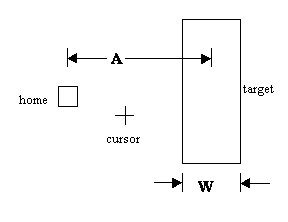First of all it is not Fitt’s Law. The name of the famous researcher is Paul Fitts, so one should be careful on spelling. Fitts's Law is basically an empirical model explaining speed-accuracy tradeoff characteristics of human muscle movement with some analogy to Shannon’s channel capacity theorem. Today, with the advent of graphical user interfaces and different styles of interaction, Fitts’ Law seems to have more importance than ever before.
The early experiments on pointing movements targeted the tasks that might be related to the worker efficiency problem, such as production line and assembly tasks. They were not targeted to HCI field because there was no GUI. Paul Fitts extended Woodworth's research which focused on telegraph operator performance substantially with his famous reciprocal tapping task to define the well-referenced Fitts’ Law (Fitts 1954). In the Fitts’ Law description of pointing, the parameters of interest are:
a. The time to move to the target
b. The movement distance from the starting position to the target center
c. Target width
Fitts started his work making an analogy of the human motor system to the well-known Shannon's channel capacity theorem. He started with the following theorem:
![]() (1)
(1)
in the above equation, C represents the effective information capacity of the communication channel, B represents the bandwidth of the channel, S and N represent signal and allowable noise power levels respectively. Fitts claimed that the distance (A) can be thought as signal power, the width of the target (W) can be thought as the allowable noise. As powerful transmitters carry more information, it becomes harder to receive when the allowable noise level increases. Similarly, it takes longer to hit targets which are further away and smaller. With this analogy, he derived the following equation, which is now known as Fitts’ Law:
![]() (2)
(2)
here, MT represents the movement time to hit the target, a and b are empirically determined constants. A represents the amplitude, which is the distance of the center of the target from the starting location and W is the target width which is shown in Figure 2.

Figure 2. The basic pointing task variables A and W.
The empirical constants a and b are found using a regression analysis on the movement time data. A typical Fitts’ regression line appears as follows:

Figure 3. Fitts’ regression line.
In almost all of the research following the Fitts' original experiment, the empirically determined constant a, is usually considered to include a constant time, such as depressing a mouse button depending on the experiment. (Note that the definition of movement time has no strong specification for the boundary conditions). Fitts defined the term Index of Difficulty (ID, shown in Figure 3), as a measure of the task difficulty as follows:
![]() (3)
(3)
Mackenzie (MacKenzie 1992), suggested a more stable model for the Fitts Law, which works better -also more like the Shannon’s original formula- for the small values of ID as follows:
![]() (2a)
(2a)
![]() (3a)
(3a)
Index of difficulty is measured in terms of "bits", which comes from the analogy with Shannon's information theorem. In addition to the index of difficulty, Fitts also defined a measure for the performance, named “Index of Performance” (IP) which is as follows:
![]() (4)
(4)
Index of performance is measured in bits per second (bits/sec), similar to the performance indices of the electronic communication devices (e.g. modems). Fitts claimed that under ideal circumstances the term a in Equation 2 would be zero, therefore the index of performance (IP) can be simply taken as ID/MT from Equation 2. However, later by other researchers, the constant a is proven to be a significant factor emphasizing the need for a more detailed analysis. The constant term a is also shown to be highly affected by the learning curve (Card 1991) of the input device and the task.
Welford, suggested a better model by separating A and W into two terms. He indicated that the effect of the target width and the target distance is not proportional and his model yields a better correlation coefficient (Welford 1968). Later researchers suggested the same. However, there is no simple index of performance associated with Welford’s model.
![]() (5)
(5)
Fitts had subjects move a stylus alternately back and forth between two separate target regions, tapping one or the other target at the end of each movement. These types of tasks are called “continuous tasks” where the subject is not expected to stop after finishing one movement but instructed to repeat the same task symmetrically as quickly as possible. In continuous tasks, the total time is divided by the number of movements to determine the average movement time for a particular target size and distance. The other type, “discrete tasks”, on the other hand, are tasks where the subject is instructed to stop after one movement and the time is measured between the start and the end-points. Subjects were instructed to make their aimed movements as rapidly as possible but land within the boundaries of the targets on at least 95% of the taps. Fitts varied the size and distance of the targets in his experiments. For his reciprocal tapping task, he obtained an ID value of about 10bits/sec.
Paul Fitts conducted three different experiments in his study; the famous reciprocal stylus tapping task with two different stylus weights (1oz and 1lb), the disc transfer task and the pin transfer tasks. The latter two tasks were more demanding in terms of the endpoint difficulties, and resulted higher constant values for the regression coefficient for similar values of indices of performances. This in fact was the first indication of the variability of the endpoint selection time in Fitts' experiment. However, Fitts did not mention this effect in detail in his original publication (Fitts 1954). Fitts’ original data was later reviewed by many researchers (Fitts 1964), (Sheridan 1979), (Welford 1986), (MacKenzie 1992) and different opinions criticized the validity of the Fitts model.
Fitts later repeated the original study by himself (Fitts 1964) in discrete form and concluded that the original formula also holds for the discrete tapping tasks. Other researchers repeated similar experiments and found that Fitts’ Law holds for discrete tasks as well.
Fitts' experiment and the Fitts’ Law equation highlight the points that are important in pointing tasks such as pointing speed, target distance, target size and accuracy. Fitts’ Law gives us a way to compare tasks, limbs and devices both in manual as well as in computer pointing. Therefore one can conclude that devices with higher indices of performance would be faster and presumably better.
On the other hand, we also have to state that, Fitts’ Law does not provide any prediction of the performance of a limb or device. It does not provide information without conducting an experiment. It does not provide an absolute measure for a limb using particular device, rather, it is a comparative tool for studying different devices, tasks, interaction techniques or limbs. Attempts to define such a universal standard exist but are still being studied (MacKenzie 1999).
With the advent of new smaller technological devices, small screens, and highly loaded user interfaces, Fitts’ Law again becomes an important tool to measure what is better what is not, in terms of interface design. For example, increased screen density (DPI) due to higher resolution graphics cards usually result in smaller menu buttons on identical monitors. Yet, advantage of having more pixels on same screen bounces back to user as longer click times and higher error rates. The problem becomes more severe as user clicks via low performer input devices such as trackpads. Using bigger LCD monitors does not improve the condition: Although the target size returns to normal, users are expected to travel longer distances on screen (Not only with input device but also with their eyes).
The key factor is, to reduce required travel distance from one location to another as user navigates through the interface and maintaining a proper size affordance for clicking. Repositioning the cursor has been suggested for this reason, however, it must be done carefully without causing user to lose locus of control. Reorganization of navigational elements, menus, buttons so that frequently used elements are placed closer to neutral cursor position is helpful to increase performance. Elimination of very narrow hierarchical menu height or elimination of hierarchical menus altogether where possible can also improve interface performance due to Fitts’s Law characteristics of such. Dynamic approaches such as zooming icons (Mac OS X desktop) and gravity wells are known as effective performance improvement methods but must be used with great caution without causing other side effects.
There are numerous computer applications that focus on performance comparison of input devices and human speed-accuracy tradeoff. One online example of such can be found at http://www.tele-actor.net/fitts/ where performance of participants are plotted after the experiment and compared against visitors hall of fame list. Another Fitts’ Law application which is organized as a game is “Fittsbits”, and can be reached at: http://www.rodo.nl/fittsbits/index.php?page=home.
37.1 How to learn more
For futher information, a good starting point could be the special issue of the International Journal of Human Computer Studies, focused on Fitts’ Law. (Volume 61 , Issue 6 , 2004, ISSN:1071-5819 , Academic Press).

